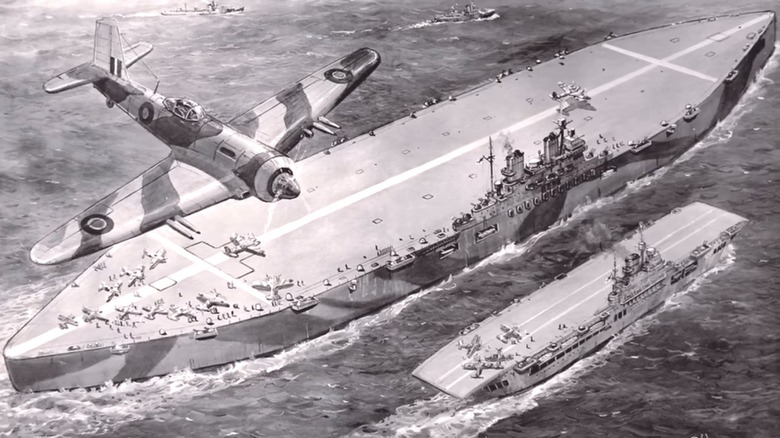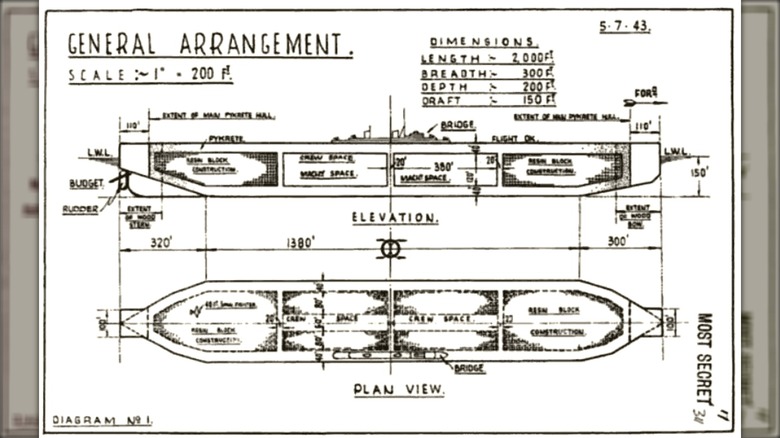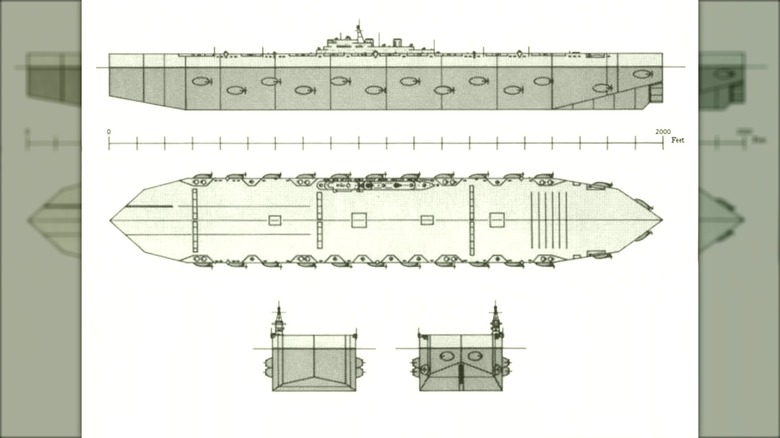An Aircraft Carrier Made From Ice And Wood Pulp: The Story Of Project Habakkuk
Aircraft carriers are the U.S. Navy's largest and most technologically advanced weapons. Since aircraft carriers were first introduced, they've grown considerably, seen massive technology upgrades, and are a key part of the United States' forward military and national interests abroad. The ability to deploy aircraft and Marines anywhere in the world is a power that is largely unchecked in modern warfare. Moreover, these aircraft carriers are extremely hard to sink.
Many innovative aircraft carriers have paved the way for today's ships, building upon designs from World War II and even World War I. Some WWII aircraft carriers were converted from preexisting vessels, while others were purpose-built in a variety of classes. While most carriers used during WWII were fairly conventional in design, there was one that defied all understanding of what an aircraft carrier should look like, be made of, and used for.
During WWII, the British initiated Project Habakkuk, which aimed to construct an aircraft carrier not made from wood and steel but from pykrete, which is a mixture of ice and wood pulp. If you're wondering why anyone would even attempt such a folly, there was a good reason for it, though Project Habakkuk remains one of the most unusual concepts of WWII. While it was never brought to fruition, the project itself is a fascinating example of ingenuity.
Project Habakkuk
By 1942, German U-boats had taken total control of an area of the Atlantic — so much so that the region had come to be known as "U-boat alley." To rescue Allied forces stranded there, an innovative scientist named Geoffrey Pike came up with a new type of carrier that was incredibly large and easy to defend. Prime Minister Winston Churchill signed off on his plan, Project Habakkuk. The scale of the project was immense and had it come to fruition, it would have been the largest warship ever constructed — even larger than the USS Gerald R. Ford, the United States' next-generation aircraft carrier.
The idea was to construct Project Habakkuk around a massive iceberg, which would keep about 90% of the vessel beneath the waves. Had it been built, Project Habakkuk would measure 2,000 feet long and 200 feet wide. It would weigh approximately 2 million tons and be able to house and launch up to 300 aircraft. Because of its intended size and mass, it would only move through the water at around 7 knots (8 mph).
The concept centered around the warship's planned mass, which would all but negate any damage brought by German U-boat torpedoes. With the ability to take repeated munitions from U-boats, the iceberg-borne aircraft carrier could theoretically locate the submerged vessel and destroy it while retaining its seaworthiness. This would effectively destroy "U-boat alley" by transforming German U-boats into little more than pea-shooters that would ultimately become tombs for the sailors within.
What happened to Project Habakkuk?
Before construction began on a full-size vessel, the British ordered the creation of a scale model. This wasn't a model like the one you'd build at home — it was 60 feet long and 30 feet wide. The construction was done as a proof of concept to determine if the ice involved could be kept frozen by a small motor and a cooling system. A crew from Canada was employed in the building project, though they weren't informed about the details of what they were building.
Eventually, they completed the scale model, and the proof of concept worked. The British assigned the construction of a full-size carrier to the Canadians to take advantage of Canada's cold waters. Ideally, the ship would be completed relatively quickly and put into service in the Atlantic, but its construction never got out of the design and planning stages.
It was quickly determined that building a full-size ship would be cost-prohibitive, and they decided the materials would be better suited to fit additional conventional aircraft carriers. This led to the abandonment of the project, and the scale model prototype was left to sink where it was built on Patricia Lake outside of Jasper, Alberta, Canada. Today, a plaque marks the historical attempt at constructing an aircraft carrier out of wood and ice.


